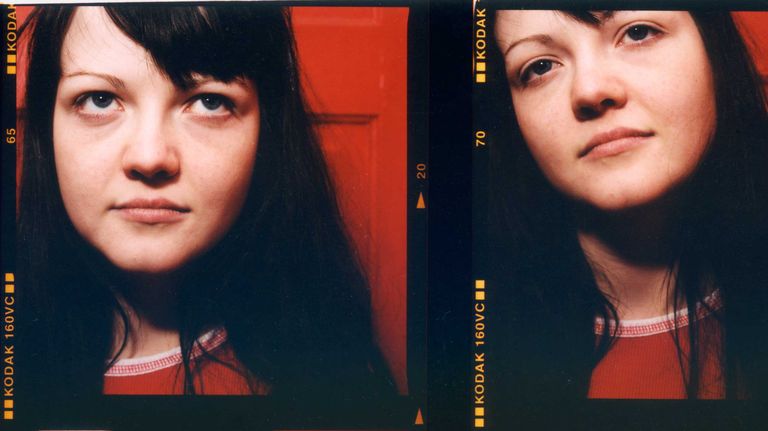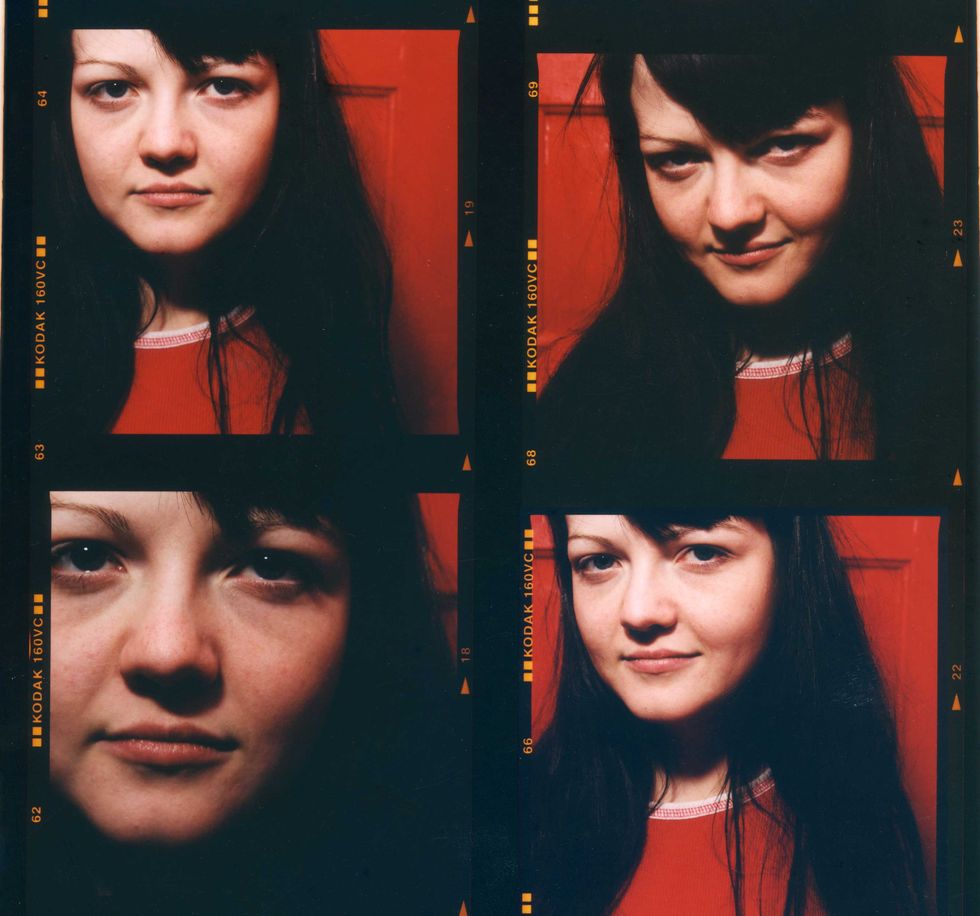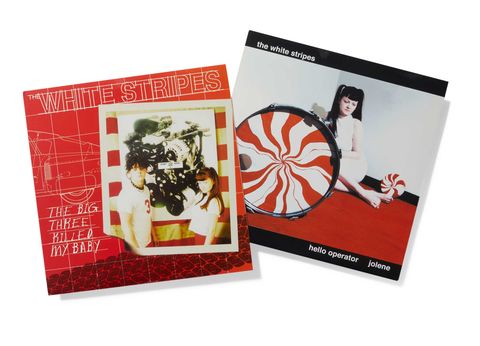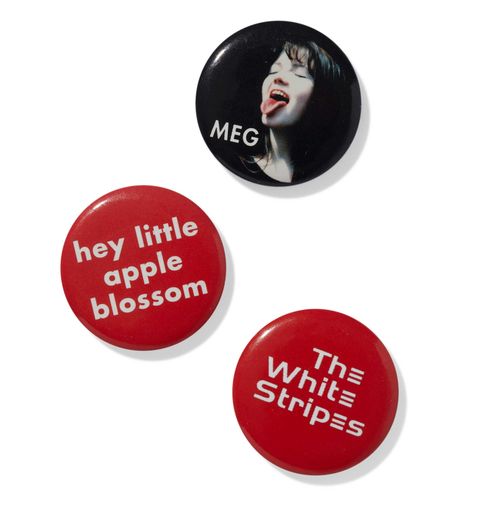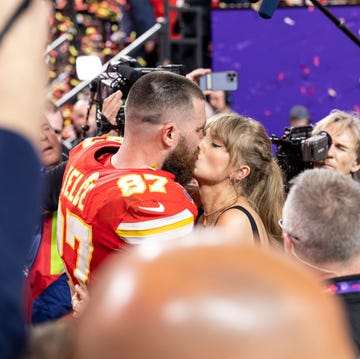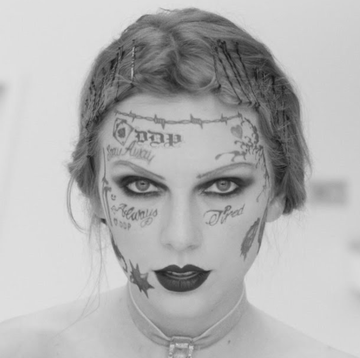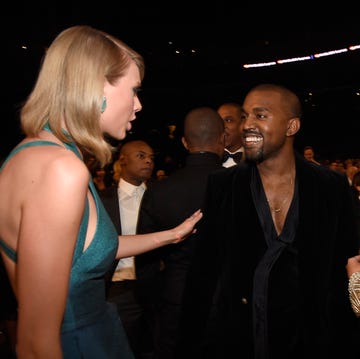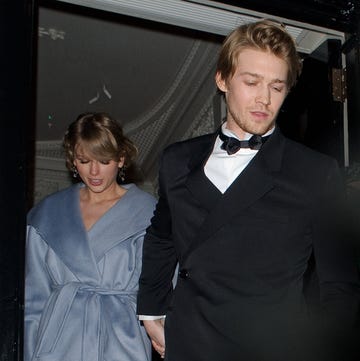“Meg really doesn’t think she feels up for any interviews. She never liked them.” This message is conveyed to me thirdhand, via the guy who ran the small Detroit label that put out the first White Stripes seven-inches back in 1998, who has spoken with the band’s extremely introverted drummer’s close friend, who apparently has delivered my request to the woman herself. After roughly three years of persistent (yet respectful) inquiry into whether Meg White might be open to talking about her legacy, I’ve inched closer to the inner sanctum. Plus, I’m told, she’s agreed to give my plea “some more thought.” It’s thrilling, to say the least.
That said, the content of this most recent response is by no means privileged. Meg’s discomfort with interviews is widely known. A few months ago, before the search results under her name were flooded with tributes defending her minimal drumming style against a critical tweet, one of the first links to come up was a YouTube video titled 15 Minutes of Meg White.
“I’m quiet. What can I say?” she’s seen asking at the 1:19-minute mark, in footage pulled from The White Stripes Under Great White Northern Lights, a documentary film that chronicled the band’s 2007 tour of every province in Canada. Less than a minute later, she can be seen squirming in her seat across from Charlie Rose, eyes down, whispering a fear of having accidentally cursed (she had not).
For those unfamiliar with The White Stripes’ origins and trajectory, here’s a crash course: In the mid- to late 1990s, Jack White asks his then-wife, Meg, to drum a simple beat in their Detroit attic while he plays guitar, sparking creative lightning. The duo plays a few shows around town, records a couple of albums, heads out of town for a few tours, and then divorces in 2000.
Next, they start referring to themselves as brother and sister, record four more studio albums (two of which reach gold status; the other two, platinum), collect four Grammys, and land three singles on the Billboard Hot 100 chart. They appear on countless magazine covers, and Meg is tapped by Marc Jacobs for a 2006 campaign, shot by Juergen Teller.
And then, on July 31, 2007, following a celebratory toast before the last show of a series of Southern U.S. tour dates, Meg confides to Ben Blackwell, Jack’s nephew and the band’s official archivist, that he’s about to see the final White Stripes show. “I was like, ‘Oh, you mean of this leg?’” Blackwell recalls now. “And she said, ‘No, I think this is the last one,’ and just walked away.”
Later, a statement from the band would announce the cancellation of their fall U.S. tour due to Meg’s acute anxiety. While today, the practice of scrapping tour stops to prioritize mental health has become somewhat commonplace, in the mid-aughts, it felt quietly revolutionary. By 2011, The White Stripes would officially call it a day, stating that the end of the band was “not due to artistic differences or lack of wanting to continue, nor any health issues as both Meg and Jack are feeling fine and in good health. It is for a myriad of reasons, but mostly to preserve what is beautiful and special about the band and have it stay that way.”
Jack, of course, would continue performing, with the Raconteurs and Dead Weather, and as a solo artist. He’d also expand his Third Man Records enterprise, opening additional stores, a vinyl-pressing plant, and a bar. But aside from a brief White Stripes performance for the last episode of Late Night With Conan O’Brien in 2009, Meg would disappear from public life. In a 2014 Rolling Stone story, Jack expressed frustration over Meg’s hermit-like existence, but admitted “all the not talking didn’t matter, because onstage? Nothing I do will top that.”
This past February, when the Rock & Roll Hall of Fame listed the duo among its annual nominees for induction, it seemed that finally the world had come around to realizing what Jack knew all along. While they didn’t make the final list, getting nominated in their first year of eligibility solidified one thing: The White Stripes have reentered the chat. And I figured, maybe, just maybe, awash in a sea of long-overdue accolades, Meg might finally agree to talk to me.
In a way, I’ve been trying to get Meg to talk for more than two decades. As The White Stripes were getting ready to release their third album, White Blood Cells, in 2001, I was the staff music writer for an alt-weekly in Detroit who was assigned a cover story on the band. On couches inside the home whose attic had birthed their band, we talked about their growing influence outside the city, and how the name of the album represented “this idea of bacteria coming at us—or just foreign things coming at us, or media, or attention on the band,” Jack told me then. When the story came out, the most common feedback I received from readers was that it was the first White Stripes story they’d seen that had featured more than one quote from Meg.
While she had a reputation around town for being reticent, Meg was fully engaged when we talked, telling me about the sweet gifts she’d received from fans and almost tearing up while watching a video an elementary school teacher had sent of her class singing “Apple Blossom.” I also vaguely recall Meg wearing a lavender tank top, which felt diametrically opposed to the band’s strict color scheme of red, white, and black.
Before White Blood Cells, the band had been, for the most part, an underground secret. Dave Buick (who ran the local label that put out the first White Stripes seven-inches) recalls being among only a handful of witnesses to their earliest shows, since “almost everybody was outside smoking.”
In 1999, following the release of their self-titled debut album by a California-based independent punk and garage label, the band landed a three-show opening gig with indie-rock stalwarts Pavement. Scott Kannberg (a.k.a. Spiral Stairs), Pavement’s guitarist and occasional vocalist, recalls his band’s bassist coming backstage while Jack and Meg were playing, and telling everyone that they needed to go watch. “He was like, ‘It’s like a young Robert Plant singing these blues songs, and his wife is drumming!’”
Corin Tucker, whose band Sleater-Kinney took the Stripes on tour with them a year later, describes being “floored” the first night. “They had an insane chemistry, and Meg’s playing was incredibly instinctual, hypnotic, and unique,” she says. “Frankly, they were a tough act to follow. We all knew that first night that they would be famous.” (Five years later, the prediction materialized when the band invited Sleater-Kinney to open for them at Washington’s Gorge Amphitheatre.)
Lizzy Goodman, who covered New York’s aughts rock revival and the scene that would later be referred to as “indie sleaze,” initially saw the White Stripes as just one of many “very cool, very self-stylized, rad garage-rock duos” populating dive bars around the country. “But when White Blood Cells came out, we were like, ‘Wait, what? Hang on. I think they might be geniuses.”
On that album’s tour, she saw the band play at Philadelphia’s Trocadero Theatre. “I was standing in the balcony, and I vividly remember the power of that guitar sound,” she says. “It felt scary in the way that you want music to—like titillating, animating, but also sort of like, is it safe to be this excited? And there was something about the dynamic between the two of them: Like, here’s this guy who is just this unleashed force of nature, and then here’s this small, feminine woman playing the bro-iest of instruments, and she seems to somehow be in charge, like she’s a conductor or something.”
The 2003 release of Elephant, which included “Seven Nation Army,” a song whose opening riff riles up sports fans to this day, would send the band hurtling into the mainstream. Pavement’s Kannberg recalls catching a White Stripes show at the Seahawks Stadium Exhibition Center in Seattle that same year. Backstage, he says, “they were just sitting by themselves, smoking cigarettes. Maybe it was just nerves from having to perform in front of, you know, 10,000 people, but they looked kind of miserable. They were like, ‘Spiral, rescue us!’”
Jack and Meg’s friends back home also noticed their growing unease with fame. “I never really talked to Meg about it, but as their career went on, you could sense she was having a hard time dealing with the celebrity part of it. I mean, I don’t think I could deal with it either,” Buick says.
The White Stripes were being heralded as a raw return to rock in an era of airbrushed pop. But Meg’s indie cred did not make her immune to the casual misogyny and rampant objectification lobbed at her more polished peers. (At one point, a risqué video supposedly featuring Meg—but which turned out to be fake—circulated among the more disturbing music blogs.) Goodman calls it the “cultural default settings” of the music scene in the early-to-mid 2000s. “I’m not gonna say all, but most of the men who behaved in a shitty way toward me back then don’t even know it,” she says. “Imagine what Meg White dealt with. I just can’t even.”
In a somewhat full circle moment, Blackwell, who manned the White Stripes email list in the early days, and who would later shadow me at work while he studied journalism at Detroit’s Wayne State University, emails to let me know Meg White is trending on Twitter. Apparently a politics reporter had responded to a tweet from National Review linking to an article praising “Seven Nation Army” by stating that “the tragedy of the White Stripes is how great they would’ve been with a half decent drummer.”
“Don’t get me started,” says Kid Congo Powers of legendary bands like the Gun Club and the Cramps. “It’s just sexist. People have been saying the whole time that her drumming was simplistic, but the band was just guitar and drums. The music they’re mining is simple music, and she’s playing it exactly right and exactly great.”
To Powers’ point, the reporter’s sentiment was nearly identical to a conversation I’d overheard in the production room of the Detroit alt-weekly as we were working on my White Stripes cover story over 20 years ago. Since social media hadn’t yet been invented, all I could do then was roll my eyes. But in 2023, the reporter’s tweet was swiftly pounced on by everyone from Questlove to model-musician Karen Elson, who concluded a supportive response with “keep my ex husband’s ex wife’s name out of your f*cking mouth.”
“That poor man got ratioed to death!” says Jessica Hopper, director of last summer’s Women Who Rock docuseries on Epix. “But it sucks. Meg’s heard that her entire career, and it’s like, I’m sorry, if you’ve ever seen them live, it’s not so much about anything other than how these two people sound together. Here is a woman who is one half of a landmark, era-defining rock band. How much more deserving does she have to fucking be? When The White Stripes came down the pike, you could see it—nine months, a year later—so many more women, more teenage girls, were playing drums.”
In 2003, Karissa Talanian was 12 years old and “one of, like, four other weirdos who cared about listening to music more than paying attention in class” in her small central Massachusetts town. One day, her mom brought home a copy of De Stijl, the White Stripes’ then three-year-old sophomore album, and it changed her life.
Her aunt and uncle took her to one of the band’s shows at the Boston Opera House a few years later. “I was hyperventilating the whole time,” Talanian says. She went home and found a list of every band that had ever played with The White Stripes and added them all on Myspace. Eventually, she taught herself to play the drums along with Meg’s beats. Today, she plays the instrument in a band called Plum, books shows at a venue in her current hometown of Chicago, and runs an independent cassette label called Eye Vybe Records.
Four years ago, through the Myspace friendships she’d developed over time, Talanian found herself backstage at a Raconteurs show. “I wound up in this super dark room, and Meg was there and all these other people I kind of knew,” she says. “When I met her, I played it super cool.” They ended up talking for hours, about their dogs and how great Led Zeppelin drummer John Bonham was.
Talanian and I talked days before the tweet involving Meg went viral, but one of the last things she said to me felt awfully prescient: “I can’t speculate at all, and I feel weird even saying it, but maybe if she hadn’t had such harsh feedback all the time, maybe The White Stripes wouldn’t have ended.”
Alt-pop star Olivia Rodrigo was less than two months old when Elephant came out, but she grew up listening to the album and remembers falling in love with “The Hardest Button to Button.” “Meg’s drums really shine on that one, and from there I dove into all their other incredible albums and became a massive fan,” she says.
“Meg’s drumming and The White Stripes in general [provided] a huge lesson to me on the value of simplicity in music. They taught me that a truly great song doesn’t need to have crazy production or layers of sound. It just needs to move you. You can sense her passion in every song she plays, and it’s so special. I think she’s one of the best drummers of our time.”
At long last, I get Meg’s friend on the line. She asks not to be named in this story, but assures me that Meg is fine and that she’s human, and as such has good days and bad days. To further ease my mind, she adds that Meg eats a Honeycrisp apple every day to keep the doctor away. “She spent 15 years traveling and touring and playing. It’s not that odd to think that she just likes to be home,” she tells me. I also learn that Meg is aware of her viral moment, and that her response was something along the lines of “oh, that again?” I ask if it might be okay to send some questions for Meg over text. She tells me to send whatever I want and that she’ll pass it along.
A few days later, Blackwell, who in addition to his archivist duties is also a co-founder and co-owner of Third Man Records, consoles me with the fact that he also tried and failed to get Meg to do an interview a couple of years ago timed to the 20th anniversary of the band’s debut album. “On the one hand, the journalism dropout in me feels that. I’m like, ‘Yeah, she needs to talk,’” Blackwell says. “But on the other hand, God, it’s so much fucking cooler that she doesn’t. It’s not like she’s living on a tropical island and no one sees or talks to her or anything like that. But her current operational way forward—this media blackout—is fucking badass, and it’s rock ’n’ roll.”
Goodman, who is very much not a journalism dropout (and whose 2017 oral history book, Meet Me in the Bathroom: Rebirth and Rock and Roll in New York City 2001–2011, was recently adapted into a documentary), agrees. “I think what I respect the most about Meg White is that it just doesn’t seem like she has any interest in whether you or I or anyone else understands her at all. She really does walk to the beat of her own drum. And doing that in life in general is difficult. But doing it when you have been as famous as she has, and have gotten used to people telling you how great you are—it’s just very hard to walk away from that.”
By this point, I’ve pretty much come to terms with the fact that I may never know what makes Meg White tick, other than what I’ve projected upon her as a fellow shy person and interminable mumbler—albeit one who unfortunately did not achieve a level of success in my twenties and thirties allowing me to not leave my house.
But I take solace in something Buick witnessed at a 2018 Detroit arena show Jack White played while promoting his third solo album. At one point during the show, he spotted Meg sitting by the side of the stage. As she listened to Jack’s new band play an old White Stripes song, “she was like, really, really getting into it,” Buick tells me. “Like, kind of drumming along, like a spark might be sparking. Hopefully someday we’ll see her back behind a drum kit.”
The day after my deadline, I receive a text from Meg’s friend. She apologizes for not getting back to me sooner, and confirms that Meg has declined to answer the questions I’d texted because it’s still technically an interview, and she’s said “no” to so many that she can’t start saying “yes” now. I thank her, tell her I understand, and ask her to do something that suddenly seems very important, which is to send Meg my best.
This article appears in the June/July 2023 issue of ELLE.
